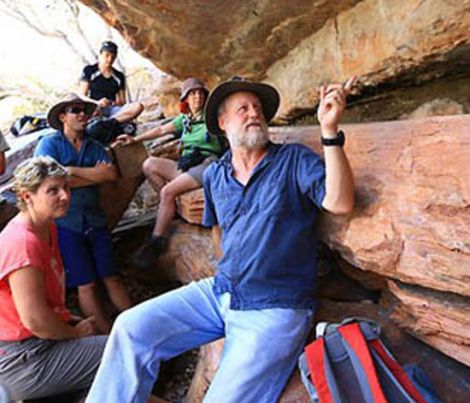Collaborative research
At Griffith University PERAHU works closely with other areas of the Griffith Centre for Social and Cultural Research, the School of Humanities, Languages and Social Science, the Australian Research Centre for Human Evolution, the Ancient DNA Sequencing Laboratory (Science, Environment, Engineering and Environment) and other sections of the university.
In Australia, PERAHU collaborates closely with Indigenous Australians wherever research is undertaken (over 20 communities). It also conducts collaborative research with archaeologists, anthropologists, dating experts, geomorphologists and many other scientists at Monash University, The Australian National University, The University of New England, The University of New South Wales, The University of Western Australia and The University of Queensland on a range of research projects and to better promote and protect rock art for future generations.
Across the globe PERAHU collaborates closely with individuals and institutions in Canada, China, South Africa, Spain, Sweden and throughout South East Asia. PERAHU director Prof Taçon is a member of the World Rock Art Alliance founded in 2017 at a Getty Conservation Institute funded international colloquium in Namibia. He also works closely with Getty staff on projects and publications.
Current Projects

Rock art history conservation and Indigenous well-being
2016-2021 ARC FL160100123 (Taçon) $2,553,00.
The contemporary significance of Australia’s rock art heritage and reasons why rock art is important for Indigenous identity and well-being but undervalued by others is a focal point of this project. New national strategies and knowledge about rock art will be produced to enhance Indigenous empowerment and well-being. Threats to Australian rock art and problems with its conservation will be addressed to ensure this rich and ancient element of national heritage is better protected for future generations. Innovative ways to manage and promote the rock art of Australia will be developed in collaboration with Indigenous peoples, especially in northern Australia, a region experiencing unprecedented development that threatens rock art landscapes.

The unknown 'Ice Age' artists of Borneo
FT170100025 (Aubert), Australian Research Council Future Fellowship
$1,011,616 plus $1,054,289 from administering organisation.
Who were the first artists? When and why did it become second nature for humans not simply to exist within the natural world, but to encode it with images of things both real and imagined? The discovery of cave paintings in Sulawesi and more recently in Borneo dating to at least 40,000 years ago has altered our understanding of the origins and spread of the first painting traditions. This project will build upon these breakthrough discoveries by constructing the first detailed portrait of the cultural and symbolic worlds of the unknown artists of Pleistocene Borneo. By doing so, it will further our knowledge about the process of the emergence of figurative art, one of the most fundamental cultural developments in the evolution of humankind.

Art at a crossroads
Art at a crossroads: Aboriginal responses to contact in northern Australia
2020–2024 SR200200062 $273,828
This research targets a vital chapter in Australia’s history: Aboriginal responses to ‘contact’ with newcomers to their land. While there is a lack of representation of Aboriginal people in the traditional archives, Aboriginal people did record their experiences in art. This project, therefore, focuses on the artistic record, in particular the rock art and bark paintings created during the last 400 years in western Arnhem Land – as key visual references of a first-hand record of Australia’s history. In this project, we will examine the ways Aboriginal people used art to navigate threats and opportunities in northern Australia while, at the same time, developing a more comprehensive and inclusive understanding of Australia’s history.
Researchers: Sally K. May (Griffith University), Paul S.C. Taçon (Griffith University), Liam Brady (Flinders University), Daryl Wesley (Flinders University), Laura Rademaker (ANU) Andrea Jalandoni (Griffith University), Joakim Goldhahn (UWA) and Luke Taylor (adjunct with Griffith University)
Research Partners: Injalak Arts (Gunbalanya) and Davidson's Arnhemland Safari
Our People
Centre staff are international leaders in the area of rock art, history and cultural evolution